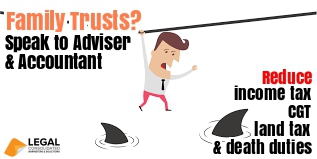Breaking up is hard to do. What happens to your SMSF when you divorce?
Mum and Dad love Self-Managed Superannuation Funds (SMSFs). There are over 500k SMSFs in Australia. We act for 4,600 accountants, lawyers and financial planners their average balance for their client’s SMSFs is about $1M.
SMSF vs divorce: an unhappy matrimony
One in three marriages ends in divorce. In a divorce, the once advantageous SMSF becomes a legal nightmare. Complex superannuation rules add to the trauma. Your SMSF is a battleground where the victors are the family and taxation lawyers, accountants and financial planners.
How to split your SMSF
Splitting your SMSF is simple when the divorce is amicable.
If the love is too far gone, then you engage family lawyers. They go to court. Family lawyers are gladiators. They delight in extracting pain and money from your lying, cheating spouse.
The Family Court may require you to write your spouse a cheque. However, it does not tell you how to find the cash. You decide which assets to sell in the SMSF.
How to value your assets
Assets differ in value depending on the valuers you use. Consequently, disputes are common. If you cannot decide then the Family Court looks at your valuations. It tells you the value.
The timing of the valuation is important. It determines how much each spouse receives. Valuation should be close to the date of the court order. However, usually, the spouses agree when the valuation occurs.
A Valuation Example
 Here is an example of my client’s suffering:
Here is an example of my client’s suffering:
Sandy and Tim are married. Although Sandy’s mother warned her Tim would be trouble, Sandy entered into an SMSF with Tim aa s joint member. The SMSF’s primary asset is the premises where Tim conducts the family business. The property is valued at $1.8M. The SMSF has $200k of shares. Tim’s interest is $1.5M. Sandy’s is $500k.
Sandy catches Tim having an affair with his marketing assistant. She is heartbroken. Every time she goes to the premises, she pictures them together. She wants nothing to do with the business. She files for divorce. The court ordered Sandy and Tim to split the SMSF in half. Sandy receives an extra $500k. SMSF divorce proves fruitful for Sandy. The SMSF’s shares and property must be valued.
Sandy wants to value the assets at the time of the court order: Div 7A.1 Superannuation Industry (Supervision) Regulations 1994 (Cth) (SISR). The court applies the prescribed interest rate of 6%.
Sandy receives:
1. Her base share, plus interest: $533,530
2. $500,000 of Tim’s base share
Her total is $1,033,530.
Tim receives:
1. His base share, plus interest: $1,511,249
2. Less $500,000, which goes to Sandy
His total is $1,011,249.
Tim wants to value the assets later when Sandy transfers her interests to her new fund: Div 7A.2 SISR. This could be years later. Assume the value increase is 4%.
Sandy receives:
1. Her base share, plus interest: $511,195
2. $500,000 of Tim’s base share
Her total is $1,011,195.
Tim receives:
1. His base share, plus interest: $1,533,584
2. Less $500,000, which goes to Sandy
His total is $1,033,584.
What if you cannot agree on the value?
It gets more difficult in SMSF divorce. What if your SMSF doesn’t have enough free cash? What if the main asset is the premises of the family business, which it must retain to operate? Do you sell the premises? This can affect other business partners. It can incur Capital Gains Tax (CGT).
Continuing with my client’s problem:
Sandy and Tim’s SMSF holds real estate worth $1.8M and $200k of shares. Depending on the valuation date, Sandy receives $1,011,195 or $1,033,530. The shares do not come close to enough to pay Sandy her interest.
Tim wants to keep the business. He can’t operate without it. He is scared to lose his livelihood. They have three options:
1. In the divorce settlement, Tim gets the family home. He takes out a loan against the house. He pays this to Sandy. She also gets the shares from the SMSF
2. Tim sets up a unit trust. It acquires the business premises. The unit trust borrows money to pay Sandy her interest
3. They liquidate the real estate asset. Sandy gets cash to the value of her interest
How CGT applies
Rollover relief is available for the transfer of assets following a divorce: s 126-140 Income Tax Assessment Act 1997 (Cth) (ITAA97). This means the leaving spouse does not pay CGT. A win against the Tax Man.
To be eligible for the CGT concession: 126-140 Family Law Act:
- You must transfer assets to a complying fund
- The transfer must be ordered by the court, or it must be due to a relationship breakdown
- You must move all entitlements from the SMSF, and
- The assets must be in their original form, such as shares or real estate. Where you liquidate the assets and transfer cash, CGT applies
Where these conditions are not satisfied, CGT is payable. Here is an example of a transfer:
‘Keep your grubby hands off my money!’ – Mary in the divorce conferences.Mary and David co-manage their SMSF. Mary’s interest is $3M and David’s interest is $1M.
Mary is a successful businessperson with a strong character. David is sick of living in Mary’s shadow. Their relationship breaks down. Mary and Davidivorcedce. The court ordered a 50-50 split of the SMSF’s assets. David receives an extra $1M on top of his base interest.
David transfers his interest to a new fund. Firstly, he transfers his base interest of $1M. He pays no CGT.
Then David transfers the additional $1M interest. Because the order specified this, he pays no CGT on it. The additional $1M was cash that Mary which David generated by selling real estate. This means CGT is payable.
SMSF Divorce: What happens during the divorce proceeding?
Divorce is often a drawn-out process. This creates difficulties with the SMSF. Just because your marriage is on the rocks, it does not absolve you from your responsibilities as a trustee. You must still make investments, produce reports and make submissions to the ATO. You must remain compliant with your membership. When one spouse leaves, you must add a co-trustee or operate through a corporate trustee.
Here is an example of non-compliance:
Zahra and Kevin have been married for 30 years. Kevin is a successful dentist. Zahra runs the house. They have an SMSF with a corporate trustee. They are directors of the corporate trustee company. The SMSF holds real estate. They purchase a large property through the SMSF. The title’s office records it as property of the company. However, the title’s office does not specify that the property is held as trustee for the SMSF.
Years later, the company goes bankrupt. It causes a relationship meltdown. Zahra and Kevidivorcedce. The company is wound up. Lawyers, accountants and financial planners advise Zahra and Kevin to sell the property to service the company’s debts. But, the ATO says the property is held as trustee for the SMSF. Selling it breaches the sole purpose test.
On top of this, Zahra has never understood the SMSF. She signs documents when Kevin tells her to. Kevin tells the court “At no stage did my wife take any interest in our SMSF. She never made financial contributions to the SMSF.” Zahra says she shouldn’t be responsible for the sale of the property because of this. This is unacceptable. Members are responsible for all decisions made in the SMSF. The court fines both of them.
How to stop the nightmare
Sadly most Superannuation Splitting Agreements no longer work. Binding Financial Agreements we find also do not work.








